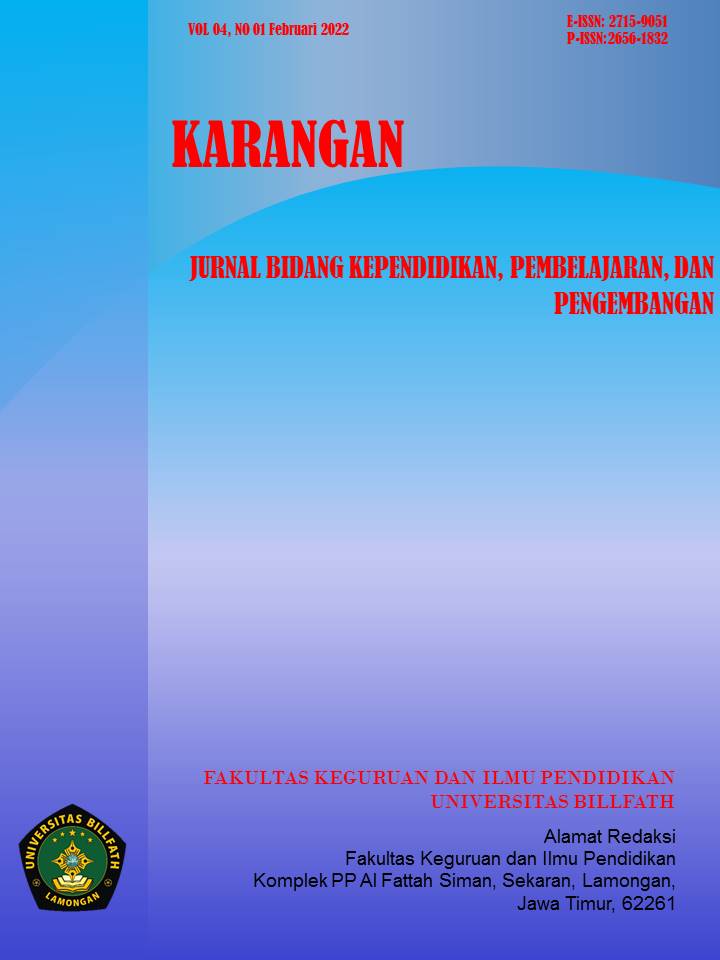Analisis Pemahaman Konsep Siswa Pada Materi Asam Basa Menggunakan Intrumen Tes Diagnostik Two-Tier
DOI:
https://doi.org/10.55273/karangan.v6i2.347Abstract
Penelitian ini bertujuan untuk mendeskripsikan pemahaman konsep siswa pada materi asam basa menggunakan tes diagnostik two-tier multiple choice. Penelitian ini melibatkan 135 siswa kelas XI dari 7 Madrasah Aliyah yang ada di Tangerang Selatan. Metode yang digunakan dalam penelitian ini adalah deskriptif kuantitatif. Hasil penelitian menunjukkan bahwa rata-rata pemahaman siswa pada materi asam basa terdiri dari 16% paham konsep, 33% miskonsepsi, dan 51% tidak paham konsep. Siswa mengalami miskonsepsi pada konsep teori asam basa, indikator asam basa, tetapan ionisasi asam basa (Ka/Kb), kekuatan asam (pH), perhitungan pH, dan konsep pH dalam lingkungan.
References
Abraham, M. R., Grzybowsky, E. B., Rener, J. W., dan Marek, E. A. (1992). Understanding and misunderstanding of eighth graders of five chemistry concepts found in textbooks. Journal of Research in Science Teaching, 29(2), 105-120.
Agogo, P. O., Onda, M. O. (2014). Identification of students’ perceived difficult concepts in Senior Secondary School Chemistry in Oju Local governmenrt area of Benue state, Nigeria. Global Educational Research Journal, 2(4), 044-049.
Artdej, R., Ratanaroutai, T., Coll, R. K., dan Thongpanchang, T. (2010). Thai Grade 11 students’ alternative conceptions for acid–base chemistry. Research in Science & Technological Education, 28(2), 167-183.
Bayrak, B. K. (2013). Using two-tier test to identify primary students’ conceptual understanding and alternative conceptions in acid base. Mevlana International Journal of Education (MIJE), 3(2), 19-26.
Cetingul, I., dan Geban, O. (2011). Using conceptual change texts with analogies for misconception in acids and bases, H. U. Journal of Education, 41(11) 112-123
Chandrasegaran, A. L., Treagust, D. F., dan Mocerino, M. (2007). The development of a two-tier multiple-choice diagnostic instrument for evaluating secondary school students’ ability to describe and explain chemical reactions using multiple levels of representation. Chemistry Education Research and Practice, 8(3), 293-307.
Citra,K., Enawaty, E., dan Junanto, T. (2015). Miskonsepsi siswa kelas VII SMP Gembala Baik Pontianak tentang asam basa. Jurnal Pendidikan dan Pembelajaran, 4(8), 1-11.
Firman, H. (2009). Ilmu dan aplikasi pendidikan. Bandung: PT Imtima.
Kala, N., Yaman, F., Ayas, A. (2012). The effectiveness of predict observe explain technique in probing students’ understanding About acid base chemistry: a case for the concepts of ph, poh, and strength. International Journal of Science and Mathematics Education, 11, 555-574
Kamcharean, C., Wattanakasiwich, P. (2013). A two-tier multiple choice question to diagnose thermodynamic misconception of Thai and Laos students. Proceedings of the 12th Asia Pacific Physics conference, 1, 017008.
Lazarowitz, R., dan Lieb, C. (2006). formative assessment pre-test to identify college students’ prior knowledge, misconceptions and learning difficulties in biology. International Journal of Science and Mathematical Education 4, 741-762.
Marsita, R. A., Priatmoko, S., dan Kusuma, E. (2010). Analisis kesulitan belajar kimia siswa SMA dalam memahami materi larutan penyangga dengan menggunakan two-tier multiple choice diagnostic instrument. Jurnal Inovasi Pendidikan Kimia, 4(1), 512-520.
Muchtar, Z., dan Harizal. (2012). Analyzing of students’ misconceptions on acid-base chemistry at Senior High Schools in Medan. Journal of Education and Practice, 3(15), 65-74.
Pinarbasi, T. (2007). Turkish Undergraduate students’ misconception on acids and bases. Journal of Baltic Science Education, 6(1), 23-33.
Prihatni, Y., Kumaidi, dan Mundilarto. (2016). Pengembangan instrumen diagnostik kognitif pada mata pelajaran IPA di SMP. Jurnal Penelitian dan Pendidikan, 20(1), 111-125.Suyanti, R. D. (2010). Strategi pembelajaran kimia. Yogyakarta: Graha Ilmu
Siswaningsih, W., Hernani., dan Rahmawati, T. (2014). Profil miskonsepsi siswa SMA pada materi hidrokarbon menggunakan tes diagnostik pilihan ganda dua tingkat. Jurnal Penelitian Pendidikan Kimia, 1(2), 200-206.
Tekkaya, C., dan Yenilmez, A. (2006). Relationships among measures of learning orientation, reasoning ability, and conceptual understanding of photosynthesis and respiration in plants for grade 8 males and females. Journal of Elementary Science Education, 18 (1), 1-14.
Tumay, H. (2016). Emergence, Learning Difficulties, and misconception in chemistry undergraduate students’ conceptualization of acid strength. Science and Aducation, 25, 21-46. doi: 10.1007/s11191-015-9799-x
Tuysuz, C. (2009). Development of two-tier diagnostic instrument and assess students’ understanding in chemistry. Scientific Research and Essay, 4(6), 626-631.
Yalcin, A. (2011). Investigation of the change of science teacher candidates’ misconception of acids-bases with respect to grade level. Journal of Turkish Science Education, 8(3), 173-175.
Downloads
Published
How to Cite
Issue
Section
License
Copyright (c) 2024 Karangan: Jurnal Bidang Kependidikan, Pembelajaran, dan Pengembangan

This work is licensed under a Creative Commons Attribution-ShareAlike 4.0 International License.









